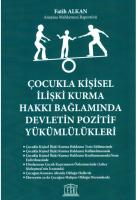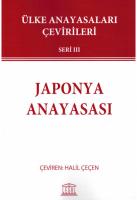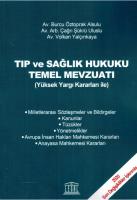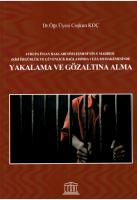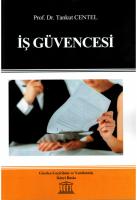The Agreement On Trade-Related Aspects Of Intellectual Property Rights (Trips) Effect On Clean Energy Technology Transfer
Liste Fiyatı :
50,00
9786053152453
364576
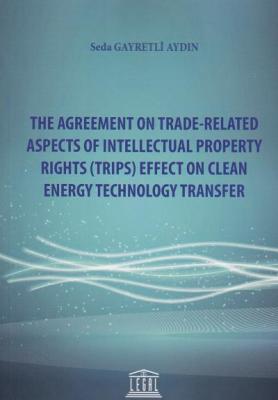
https://www.hukukfuar.com/the-agreement-on-trade-related-aspects-of-intellectual-property-rights-trips-effect-on-clean-energy-technology-transfer-legal-yayinevi-seda-gayretli-aydin
The Agreement On Trade-Related Aspects Of Intellectual Property Rights (Trips) Effect On Clean Energy Technology Transfer
50.00
Bu çalışma, fikri mülkiyet hukuku, teknoloji transferi ve iklim değişikliği arasındaki kesişime odaklanmaktadır. Bu çalışmanın amacı fikri mülkiyet haklarını çevresel haklarla dengelemektir. Kitap, TRIPS, UNFCCC ve WIPO’nun 2007 Kalkınma Gündemi, fikri mülkiyet ve iklim değişikliği ile ilgili uluslararası kuralları içermekte olup, ağırlıklı olarak TRIPS üzerinde yoğunlaşmıştır.
TABLE OF CONTENTS
TABLE OF CONTENTS
DEDICATION
PREFACE
ABBREVIATIONS
DEDICATION
PREFACE
ABBREVIATIONS
CHAPTER
INTRODUCTION
1.1 Background
INTRODUCTION
1.1 Background
CHAPTER
CLIMATE CHANGE BATTLE
2.1. INTRODUCTION
2.2. CLIMATE CHANGE
2.2.1. CAUSES OF CLIMATE CHANGE
2.2.2. CURRENT IMPACTS OF CLIMATE CHANGE
1. Weather and Climate ( Extreme Weather Events )
2. Oceans (Sea Levels Rise and Coastal Impacts)
3. Snow and ice
4. Society and Ecosystem (Wildlife and Endangered Species)
5. Human Health
2.2.3. Future Impacts of Climate Change
2.3. CLIMATE CHANGE AGREEMENTS AND CONFERENCES
2.3.1. Background Information
2.3.2. World Meteorological Organization WMO (First World Climate Conference)
2.3.3. Montreal Protocol on Substances that Deplete the Ozone Layer 1987
2.3.4. Intergovernmental Panel on Climate Change 1988
2.3.5. Nations Framework Convention on Climate Change 1992
1. Kyoto Protocol 1997
2. Bali Action Plan 2007
3. Cancun Agreements
4. Durban Platform
5. Doha Climate Gateway
6. Warsaw Outcomes
7. The Universal Climate Change Treaty - Paris Agreement
2.4 CLIMATE CHANGE POLICIES OF WTO MEMBERS
2.4.1 The United States
2.4.2 The European Union
2.4.3. China
2.4.4. Turkey
CLIMATE CHANGE BATTLE
2.1. INTRODUCTION
2.2. CLIMATE CHANGE
2.2.1. CAUSES OF CLIMATE CHANGE
2.2.2. CURRENT IMPACTS OF CLIMATE CHANGE
1. Weather and Climate ( Extreme Weather Events )
2. Oceans (Sea Levels Rise and Coastal Impacts)
3. Snow and ice
4. Society and Ecosystem (Wildlife and Endangered Species)
5. Human Health
2.2.3. Future Impacts of Climate Change
2.3. CLIMATE CHANGE AGREEMENTS AND CONFERENCES
2.3.1. Background Information
2.3.2. World Meteorological Organization WMO (First World Climate Conference)
2.3.3. Montreal Protocol on Substances that Deplete the Ozone Layer 1987
2.3.4. Intergovernmental Panel on Climate Change 1988
2.3.5. Nations Framework Convention on Climate Change 1992
1. Kyoto Protocol 1997
2. Bali Action Plan 2007
3. Cancun Agreements
4. Durban Platform
5. Doha Climate Gateway
6. Warsaw Outcomes
7. The Universal Climate Change Treaty - Paris Agreement
2.4 CLIMATE CHANGE POLICIES OF WTO MEMBERS
2.4.1 The United States
2.4.2 The European Union
2.4.3. China
2.4.4. Turkey
CHAPTER III
TRANSFER OF CLEAN TECHNOLOGY
3.1. INTRODUCTION
3.2. CLEAN ENERGY
3.2.1 Background Information
3.2.2 Fossil Fuels
3.2.3. Nuclear Energy
3.2.4. Renewable Energy Sources
1. Solar Energy
2. Wind Energy
3. Geothermal Energy
4. Biomass Energy
5. Hydropower
3.3 RENEWABLE ENERGY AS A SOLUTION TO CLIMATE CHANGE BATTLE
3.3.1. Energy conservation and efficiency
3.3.2. Carbon capture storage and trade, and carbon tax
3.3.3. Renewable energy
3.4. TRANSFER OF CLEAN ENERGY TECHNOLOGY AND INTERNATIONAL LAW
3.4.1 CLEAN ENERGY TECHNOLOGY
1. Definition of Technology
2. History and Definition of Transfer of Technology
3.4.2 INTERNATIONAL LAW OF CLEAN TECHNOLOGY TRANSFER
1. UNCTAD’s Draft of International Code of Technology Transfer
2. Montreal Protocol on Substances that Deplete the Ozone Layer 1987
3. United Nations Framework Convention on Climate Change
4. KYOTO PROTOCOL
5. BALI ACTION PLAN
6. COPENHAGEN ACCORD
7. CANCUN AGREEMENTS
8. DURBAN PLATFORM FOR ENHANCED ACTION
9. DOHA CLIMATE GATEWAY
10. INTERNATIONAL CLIMATE CHANGE AGREEMENT –PARIS AGREEMENT
3.5. CONCLUSION
TRANSFER OF CLEAN TECHNOLOGY
3.1. INTRODUCTION
3.2. CLEAN ENERGY
3.2.1 Background Information
3.2.2 Fossil Fuels
3.2.3. Nuclear Energy
3.2.4. Renewable Energy Sources
1. Solar Energy
2. Wind Energy
3. Geothermal Energy
4. Biomass Energy
5. Hydropower
3.3 RENEWABLE ENERGY AS A SOLUTION TO CLIMATE CHANGE BATTLE
3.3.1. Energy conservation and efficiency
3.3.2. Carbon capture storage and trade, and carbon tax
3.3.3. Renewable energy
3.4. TRANSFER OF CLEAN ENERGY TECHNOLOGY AND INTERNATIONAL LAW
3.4.1 CLEAN ENERGY TECHNOLOGY
1. Definition of Technology
2. History and Definition of Transfer of Technology
3.4.2 INTERNATIONAL LAW OF CLEAN TECHNOLOGY TRANSFER
1. UNCTAD’s Draft of International Code of Technology Transfer
2. Montreal Protocol on Substances that Deplete the Ozone Layer 1987
3. United Nations Framework Convention on Climate Change
4. KYOTO PROTOCOL
5. BALI ACTION PLAN
6. COPENHAGEN ACCORD
7. CANCUN AGREEMENTS
8. DURBAN PLATFORM FOR ENHANCED ACTION
9. DOHA CLIMATE GATEWAY
10. INTERNATIONAL CLIMATE CHANGE AGREEMENT –PARIS AGREEMENT
3.5. CONCLUSION
CHAPTER IV
INTERNATIONAL INTELLECTUAL PROPERTY AND TECHNOLOGY TRANSFER
4.1. INTRODUCTION
4.2. INTERNATIONAL INTELLECTUAL PROPERTY
4.2.1 Intellectual Property
4.2.2 Backgrounds of International Intellectual Property Law
4.3 WORLD INTELLECTUAL PROPERTY ORGANIZATION
4.3.1 CORE ACTIVITIES OF WIPO
4.3.2 The WIPO and TRANSFER of TECHNOLOGY
1) WIPO’s Development Agenda
2) WIPO’s technology databases (WIPO Gold)
a. Technology Databases (Patentscope)
b. Laws and Treaties (WIPO Lex )
3) WIPO’s Technology Innovation and Support Centers (TISCs)
4) WIPO’s Sustainable Technology Marketplace (WIPO Green)
5) WIPO’s Patent landscapes reports
6) WIPO’s Technology Transfer Reports
7) WIPO - WTO Joint Workshops and WIPO’s seminars related to TRIPS Agreement
8) WIPO’s Technology Transfer Seminars
INTERNATIONAL INTELLECTUAL PROPERTY AND TECHNOLOGY TRANSFER
4.1. INTRODUCTION
4.2. INTERNATIONAL INTELLECTUAL PROPERTY
4.2.1 Intellectual Property
4.2.2 Backgrounds of International Intellectual Property Law
4.3 WORLD INTELLECTUAL PROPERTY ORGANIZATION
4.3.1 CORE ACTIVITIES OF WIPO
4.3.2 The WIPO and TRANSFER of TECHNOLOGY
1) WIPO’s Development Agenda
2) WIPO’s technology databases (WIPO Gold)
a. Technology Databases (Patentscope)
b. Laws and Treaties (WIPO Lex )
3) WIPO’s Technology Innovation and Support Centers (TISCs)
4) WIPO’s Sustainable Technology Marketplace (WIPO Green)
5) WIPO’s Patent landscapes reports
6) WIPO’s Technology Transfer Reports
7) WIPO - WTO Joint Workshops and WIPO’s seminars related to TRIPS Agreement
8) WIPO’s Technology Transfer Seminars
CHAPTER V
THE WORLD TRADE ORGANIZATION AND THE TRADE-RELATED ASPECTS OF INTELLECTUAL PROPERTY RIGHTS (TRIPS) AGREEMENT
5.1 INTRODUCTION
5.2. BACKGROUNDS OF THE TRIPS AGREEMENT
5.2.1. PLACE OF THE TRIPS AGREEMENT WITHIN THE WORLD TRADE ORGANIZATION
5.2.2. THE TRIPS AGREEMENT’S ADVANTAGES FOR DEVELOPING COUNTRIES AND THE LEAST DEVELOPED COUNTRIES.
1) Technology Transfer
2) Incentives and Enterprises
3) Technical Corporation
4) Transitional Periods
5.2.3. OUTLINE OF THE TRIPS AGREEMENT
THE WORLD TRADE ORGANIZATION AND THE TRADE-RELATED ASPECTS OF INTELLECTUAL PROPERTY RIGHTS (TRIPS) AGREEMENT
5.1 INTRODUCTION
5.2. BACKGROUNDS OF THE TRIPS AGREEMENT
5.2.1. PLACE OF THE TRIPS AGREEMENT WITHIN THE WORLD TRADE ORGANIZATION
5.2.2. THE TRIPS AGREEMENT’S ADVANTAGES FOR DEVELOPING COUNTRIES AND THE LEAST DEVELOPED COUNTRIES.
1) Technology Transfer
2) Incentives and Enterprises
3) Technical Corporation
4) Transitional Periods
5.2.3. OUTLINE OF THE TRIPS AGREEMENT
5.2.4. GENERAL PROVISIONS AND BASIC PRINCIPLES of THE TRIPS AGREEMENT
1) Minimum Standard Agreement ( Article 1: Nature and Scope of Obligations)
2) Intellectual Property Protection (Article 2)
3) National treatment (Article 3)
4) Most Favored Nation Treatment (Article 4)
5) Multilateral Agreements on Acquisition or Maintenance of Protection (Article 5)
6) Exhaustion (Article 6)
7) Objectives (Article 7)
8) Principles (Article 8)
5.2.5. IMPLEMENTATION OF THE TRIPS AGREEMENT
5.2.6. HOW the TRIPS AGREEMENT IS DIFFERENT THAN WIPO GOVERNED INTERNATIONAL INTELLECTUAL PROPERTY AGREEMENTS
1) Minimum Standard Agreement ( Article 1: Nature and Scope of Obligations)
2) Intellectual Property Protection (Article 2)
3) National treatment (Article 3)
4) Most Favored Nation Treatment (Article 4)
5) Multilateral Agreements on Acquisition or Maintenance of Protection (Article 5)
6) Exhaustion (Article 6)
7) Objectives (Article 7)
8) Principles (Article 8)
5.2.5. IMPLEMENTATION OF THE TRIPS AGREEMENT
5.2.6. HOW the TRIPS AGREEMENT IS DIFFERENT THAN WIPO GOVERNED INTERNATIONAL INTELLECTUAL PROPERTY AGREEMENTS
CHAPTER VI
THE TRIPS AGREEMENT’S TECHNOLOGY TRANSFER RELATED ARTICLES
6.1. Introduction
6.2. Preamble of the WTO Agreement
6.3. Preamble of the TRIPS Agreement
6.4. Objectives (Article 7)
6.5. Principles (Article 8)
6.6. Patentable subject matter (Article 27)
6.7. Exceptions to Rights Conferred (Article 30)
6.7.1. Experimental Use and Research
6.7.2. Bolar – Early Working Exception
6.8. Parallel Imports
6.9. Compulsory Licensing (Article 31)
6.10 Control of Anti- Competitive Practices in Contractual Licenses (Article 40)
6.11. Technology Transfer Mechanism (Article 66)
6.12. Security Exceptions (Article 73)
6.13 Other Articles may be used to facilitate clean technology transfer
CHAPTER VII
CONCLUSION AND SUGGESTIONS
7.1. SUMMARY
7.2 ADVANTAGES OF THE TRIPS AGREEMENT
7.3. DISADVANTAGES OF THE TRIPS AGREEMENT
7.4. ALTERNATIVE SOLUTIONS TO TECHNOLOGY TRANSFER
7.4.1. Patent Pools
7.4.2. Clean Technology Awards
7.4.3. The Eco-Patent Commons
7.4.4. Carbon and Trade Market & Creative Common Licenses joint model
7.5. SUGGESTIONS
7.6. CONCLUSION
BIBLIOGRAPHY
CONCLUSION AND SUGGESTIONS
7.1. SUMMARY
7.2 ADVANTAGES OF THE TRIPS AGREEMENT
7.3. DISADVANTAGES OF THE TRIPS AGREEMENT
7.4. ALTERNATIVE SOLUTIONS TO TECHNOLOGY TRANSFER
7.4.1. Patent Pools
7.4.2. Clean Technology Awards
7.4.3. The Eco-Patent Commons
7.4.4. Carbon and Trade Market & Creative Common Licenses joint model
7.5. SUGGESTIONS
7.6. CONCLUSION
BIBLIOGRAPHY
- Açıklama
- Bu çalışma, fikri mülkiyet hukuku, teknoloji transferi ve iklim değişikliği arasındaki kesişime odaklanmaktadır. Bu çalışmanın amacı fikri mülkiyet haklarını çevresel haklarla dengelemektir. Kitap, TRIPS, UNFCCC ve WIPO’nun 2007 Kalkınma Gündemi, fikri mülkiyet ve iklim değişikliği ile ilgili uluslararası kuralları içermekte olup, ağırlıklı olarak TRIPS üzerinde yoğunlaşmıştır.
TABLE OF CONTENTSTABLE OF CONTENTS
DEDICATION
PREFACE
ABBREVIATIONSCHAPTER
INTRODUCTION
1.1 BackgroundCHAPTER
CLIMATE CHANGE BATTLE
2.1. INTRODUCTION
2.2. CLIMATE CHANGE
2.2.1. CAUSES OF CLIMATE CHANGE
2.2.2. CURRENT IMPACTS OF CLIMATE CHANGE
1. Weather and Climate ( Extreme Weather Events )
2. Oceans (Sea Levels Rise and Coastal Impacts)
3. Snow and ice
4. Society and Ecosystem (Wildlife and Endangered Species)
5. Human Health
2.2.3. Future Impacts of Climate Change
2.3. CLIMATE CHANGE AGREEMENTS AND CONFERENCES
2.3.1. Background Information
2.3.2. World Meteorological Organization WMO (First World Climate Conference)
2.3.3. Montreal Protocol on Substances that Deplete the Ozone Layer 1987
2.3.4. Intergovernmental Panel on Climate Change 1988
2.3.5. Nations Framework Convention on Climate Change 1992
1. Kyoto Protocol 1997
2. Bali Action Plan 2007
3. Cancun Agreements
4. Durban Platform
5. Doha Climate Gateway
6. Warsaw Outcomes
7. The Universal Climate Change Treaty - Paris Agreement
2.4 CLIMATE CHANGE POLICIES OF WTO MEMBERS
2.4.1 The United States
2.4.2 The European Union
2.4.3. China
2.4.4. TurkeyCHAPTER III
TRANSFER OF CLEAN TECHNOLOGY
3.1. INTRODUCTION
3.2. CLEAN ENERGY
3.2.1 Background Information
3.2.2 Fossil Fuels
3.2.3. Nuclear Energy
3.2.4. Renewable Energy Sources
1. Solar Energy
2. Wind Energy
3. Geothermal Energy
4. Biomass Energy
5. Hydropower
3.3 RENEWABLE ENERGY AS A SOLUTION TO CLIMATE CHANGE BATTLE
3.3.1. Energy conservation and efficiency
3.3.2. Carbon capture storage and trade, and carbon tax
3.3.3. Renewable energy
3.4. TRANSFER OF CLEAN ENERGY TECHNOLOGY AND INTERNATIONAL LAW
3.4.1 CLEAN ENERGY TECHNOLOGY
1. Definition of Technology
2. History and Definition of Transfer of Technology
3.4.2 INTERNATIONAL LAW OF CLEAN TECHNOLOGY TRANSFER
1. UNCTAD’s Draft of International Code of Technology Transfer
2. Montreal Protocol on Substances that Deplete the Ozone Layer 1987
3. United Nations Framework Convention on Climate Change
4. KYOTO PROTOCOL
5. BALI ACTION PLAN
6. COPENHAGEN ACCORD
7. CANCUN AGREEMENTS
8. DURBAN PLATFORM FOR ENHANCED ACTION
9. DOHA CLIMATE GATEWAY
10. INTERNATIONAL CLIMATE CHANGE AGREEMENT –PARIS AGREEMENT
3.5. CONCLUSIONCHAPTER IV
INTERNATIONAL INTELLECTUAL PROPERTY AND TECHNOLOGY TRANSFER
4.1. INTRODUCTION
4.2. INTERNATIONAL INTELLECTUAL PROPERTY
4.2.1 Intellectual Property
4.2.2 Backgrounds of International Intellectual Property Law
4.3 WORLD INTELLECTUAL PROPERTY ORGANIZATION
4.3.1 CORE ACTIVITIES OF WIPO
4.3.2 The WIPO and TRANSFER of TECHNOLOGY
1) WIPO’s Development Agenda
2) WIPO’s technology databases (WIPO Gold)
a. Technology Databases (Patentscope)
b. Laws and Treaties (WIPO Lex )
3) WIPO’s Technology Innovation and Support Centers (TISCs)
4) WIPO’s Sustainable Technology Marketplace (WIPO Green)
5) WIPO’s Patent landscapes reports
6) WIPO’s Technology Transfer Reports
7) WIPO - WTO Joint Workshops and WIPO’s seminars related to TRIPS Agreement
8) WIPO’s Technology Transfer SeminarsCHAPTER V
THE WORLD TRADE ORGANIZATION AND THE TRADE-RELATED ASPECTS OF INTELLECTUAL PROPERTY RIGHTS (TRIPS) AGREEMENT
5.1 INTRODUCTION
5.2. BACKGROUNDS OF THE TRIPS AGREEMENT
5.2.1. PLACE OF THE TRIPS AGREEMENT WITHIN THE WORLD TRADE ORGANIZATION
5.2.2. THE TRIPS AGREEMENT’S ADVANTAGES FOR DEVELOPING COUNTRIES AND THE LEAST DEVELOPED COUNTRIES.
1) Technology Transfer
2) Incentives and Enterprises
3) Technical Corporation
4) Transitional Periods
5.2.3. OUTLINE OF THE TRIPS AGREEMENT5.2.4. GENERAL PROVISIONS AND BASIC PRINCIPLES of THE TRIPS AGREEMENT
1) Minimum Standard Agreement ( Article 1: Nature and Scope of Obligations)
2) Intellectual Property Protection (Article 2)
3) National treatment (Article 3)
4) Most Favored Nation Treatment (Article 4)
5) Multilateral Agreements on Acquisition or Maintenance of Protection (Article 5)
6) Exhaustion (Article 6)
7) Objectives (Article 7)
8) Principles (Article 8)
5.2.5. IMPLEMENTATION OF THE TRIPS AGREEMENT
5.2.6. HOW the TRIPS AGREEMENT IS DIFFERENT THAN WIPO GOVERNED INTERNATIONAL INTELLECTUAL PROPERTY AGREEMENTS
CHAPTER VI
THE TRIPS AGREEMENT’S TECHNOLOGY TRANSFER RELATED ARTICLES
6.1. Introduction
6.2. Preamble of the WTO Agreement
6.3. Preamble of the TRIPS Agreement
6.4. Objectives (Article 7)
6.5. Principles (Article 8)
6.6. Patentable subject matter (Article 27)
6.7. Exceptions to Rights Conferred (Article 30)
6.7.1. Experimental Use and Research
6.7.2. Bolar – Early Working Exception
6.8. Parallel Imports
6.9. Compulsory Licensing (Article 31)
6.10 Control of Anti- Competitive Practices in Contractual Licenses (Article 40)
6.11. Technology Transfer Mechanism (Article 66)
6.12. Security Exceptions (Article 73)
6.13 Other Articles may be used to facilitate clean technology transferCHAPTER VII
CONCLUSION AND SUGGESTIONS
7.1. SUMMARY
7.2 ADVANTAGES OF THE TRIPS AGREEMENT
7.3. DISADVANTAGES OF THE TRIPS AGREEMENT
7.4. ALTERNATIVE SOLUTIONS TO TECHNOLOGY TRANSFER
7.4.1. Patent Pools
7.4.2. Clean Technology Awards
7.4.3. The Eco-Patent Commons
7.4.4. Carbon and Trade Market & Creative Common Licenses joint model
7.5. SUGGESTIONS
7.6. CONCLUSION
BIBLIOGRAPHYStok Kodu:9786053152453Boyut:16 x 24 cmSayfa Sayısı:209Basım Yeri:İstanbulBaskı:1Basım Tarihi:Nisan 2018Kapak Türü:Karton KapaklıKağıt Türü:I.HamurDili:İngilizce
Yorumlar (0)
Yorum yaz
Bu kitabı henüz kimse eleştirmemiş.









